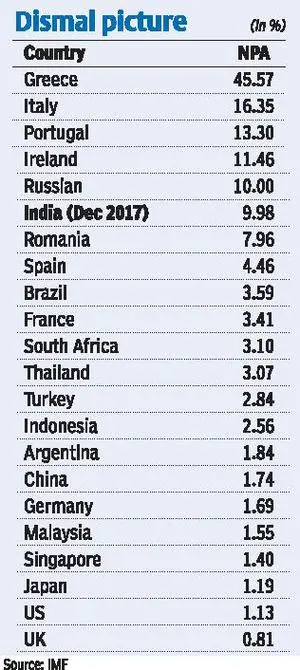hough globally India’s position is unsatisfactory, time-bound resolution of NPAs under IBC should ease banks’ burden
The non-performing asset (NPA) issue facing banks has dominated headlines for several months now and the fact that we are still unsure of whether or not all have been recognised does cause some discomfort. In this context it is compelling to see how the Indian banking system stands on a global yardstick.
This is important because NPAs have resulted due to several judgment calls made in the past, which in hindsight were incorrect. Lending operations in the banking system are linked with expectations of how the economy will behave. If the economy is growing at a fast pace, it is assumed that the same will prevail in future. The problem hence, is that there always seem to be progressive expectations when the economy does well. This is where judgement gets blurred and errors get into the system as credit evaluation goes awry.
 Business cycles
Business cycles
When business cycles are buoyant and interest rates low, companies go in for big investments and banks are gung-ho as everything looks plausible. Growth in bank credit averaged 19 per cent per annum between FY08 and FY12 when the repo rate was first lowered from 7.75 per cent to 5 per cent before being increased to 8.5 per cent by FY12.
During these phases, the interest cost also ceases to matter as it is assumed that it is a small component of the cost and can be absorbed with the topline growing rapidly. Corporate sales growth in those years averaged 15-20 per cent on a recurring basis.
It is not surprising that bank credit during this period grew rapidly, by an average annual rate of 19 per cent. It was then the economy was impacted by various controversies in the natural resources sectors which, in particular, thwarted investments and led to an increase in stalled projects as bureaucrats were not willing to take decisions. Bank credit growth subsequently slowed and the average growth rate came down to 11 per cent between FY13 and FY17.
This surrealism was hence shattered as the economy moved from a canter to a trot (GDP growth also slid by around 1 per cent per annum for these two periods with different base years), leaving banks holding the rotten eggs. This does provoke a debate on whether or not we have brought about high growth by inflating investment through erroneous lending.
In several countries that saw rapid growth — starting with the East Asian Tiger economies in the 1980s and 1990s as well as China when it posted growth of over 10 per cent on a sustained basis on the back of an investment-driven model — there was reason to believe that financial decisions were fogged by a misleading futuristic windshield.
At 10 per cent, India is in the more ‘unsatisfactory’ league of nations with high NPAs.
The ones which are more problematic are Greece, Italy, Portugal, Ireland and Russia. Quite interestingly, the top four were part of the PIIGS group which epitomised the euro crisis of 2010. Spain has moved away with a ratio of 4.5 per cent, while the rest still struggle to rein them.
One thing that stands out is that some of the Latin American nations like Brazil and Argentina are doing much better on this front while even Turkey, which has other challenges in terms of currency and growth, has a low ratio of less than 3 per cent. India’s NPAs were also around 3 per cent when there were various camouflages available under corporate debt restructuring.
However, ever since the RBI brought about the concept of asset quality recognition in 2016, banks progressively revealed the same which has, in turn, stressed the system. The very developed nations with large economies like the US, the UK, Japan and Germany have sound banking systems with NPA ratios of less than 2 per cent, while China scores well at 1.7 per cent.
The NPA issue does not just end with an adverse portfolio. As provisions have been made on an accelerated recognition of the same, the profitability of banks has been affected.
The return on assets at 0.33 per cent for Indian banks is comparable to those of the very developed countries. However, this could lead to a misleading conclusion that Indian banking system is on par with them.
Western banks operate on smaller interest rate spreads on much larger balance sheets which lowers their return on assets. Similarly, a larger volume of capital lowers the return on net worth. This means that if the interest rate spreads were lowered by Indian banks then profitability at the present levels would not be maintained. Therefore, in a way both deposit-holders as well as borrowers are confronting unfavourable interest rate schedules.
The positive side
The good part of the story is that hopefully all the NPAs have been placed on the table. And, the IBC (Insolvency and Bankruptcy Code) has seen the first big resolution and there would be more to follow. This is critical because the recovery rates in India have been very low at 15-20 per cent while the system needs to move towards 50-75 per cent over a period of time.
Given the time-bound manner of resolution of the NPAs, there is hope that there would the proverbial light at the end of a tunnel which has a fixed length. The system may have to struggle for another year or so, but the 2019-20 fiscal could be brighter.

No comments:
Post a Comment